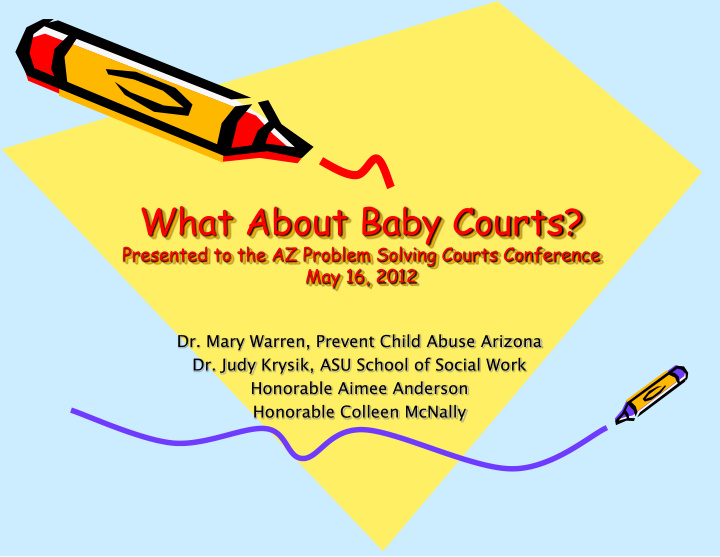



What About Baby Courts? Presented to the AZ Problem Solving Courts Conference May 16, 2012 Dr. Mary Warren, Prevent Child Abuse Arizona Dr. Judy Krysik, ASU School of Social Work Honorable Aimee Anderson Honorable Colleen McNally
What We Know……. Infants and toddlers are widely recognized as our most vulnerable population Early, secure and consistent relationships with adult caregivers contribute to healthy brain development Later academic success is directly related to a young child’s early emotional and social development Intervention is more effective and less costly when provided earlier rather than later in a child’s life
Children Under the Age of Five Years: *Highest fatality rates as a result of abuse and neglect * Highest rates of entry to child welfare system *Stay in the system longer * Less likely to reunify * Higher rates of re-entry post-reunification
Arizona Entry Rate per 1,000 Children by Age First Admissions 16 0 14 1 12 2 10 3 - 5 8 6 - 8 6 9 - 11 4 12 - 14 15 - 17 2 0 2006 2007 2008 2009 2010
Children birth to five * All children 0-5 Brain develops to 85% of adult size • Develop and learn within relationships • * Children in foster care experience high levels of stress during critical periods of • brain development higher rates of developmental delay and • neurological impairment
Attachment • Genetically wired to form attachment with older, wiser protector • Builds thru relationships, interactions • Birth to 7 months
Attachment Secure Insecure
Trauma • Genetically wired to fear predators (scary things, hidden things, harm to us/others) • Witnessing violence or trauma impacts the manner in which the brain develops
Trauma • Disrupts development • Predisposes child to adult depression, anxiety disorder, addictions, chronic disease • Future relationships impaired
Most Harmful Trauma • When your caregiver is being hurt • When your caregiver hurts you In either case, young child experiences as an overwhelming threat to survival
Best for Babies • National Initiative of Zero to Three: Court Teams for Maltreated Infants and Toddlers • Arizona: 12 of 15 counties • Funding from AOC & First Things First
Goals • To increase shared knowledge of unique needs of infants and toddlers in child welfare system • To improve their outcomes through timely, evidence-informed, coordinated services and supports
Core Components • Judicial leadership & oversight • Recognition of need for change • Information on child’s needs • Capacity to focus on well-being
Core Components • Coordinated services for – Parent – Child • On-going assessments • Court as time keeper
Best Practices • First placement, last placement • Focus on healing, thriving • Concurrent planning • Frequent child-centered visitation • Successful reunification • Twelve months to permanency
Team • Judges • CPS • Foster parents • Attorneys • CASAs
Produced by Zero To Three SAFE BABIES COURT TEAMS
Cradle to Crayons Maricopa County Child Welfare Center
Cradle to Crayons Why? 44% of dependency petitions filed in Maricopa County involve at least one child under the age of three. 57% of dependency petitions involve at least one child under 5 years old. 41.7% of children in foster care in AZ are under 5 years old. 2010 national statistics show children under age 2 comprised 61% of fatalities due to maltreatment.
Cradle to Crayons What Maricopa County Juvenile Court is doing: Assigning specific judicial officers to manage baby • cases Concurrent planning on every case • Ordering more frequent hearings • Ordering more frequent visits • • Identifying appropriate community stakeholders for involvement in family treatment Specific 0-3 training •
Cradle to Crayons Maricopa County Child Welfare Center Problems: • Caretaker history of mistreatment • Unskilled young parent(s) • Languishing in System • Poor Bonding and Attachment • Uncoordinated Service Delivery
Cradle to Crayons Maricopa County Child Welfare Center Solutions: • Co-location of services • Collaboration of life stabilizing resources • Increase opportunity for parent and child to bond and attach • Increase frequency of visits • Improve quality of visits – visit coaching
Cradle to Crayons Maricopa County Child Welfare Center Identify stakeholders Forge partnerships Facilitate strategic planning meetings Program planning and development Staffing requirements Spatial needs
Cradle to Crayons Maricopa County Child Welfare Center A Collaborative project with community partners to improve outcomes for high-risk infants, toddlers, and their families. A Dependency court with strong judicial leadership and the collaboration and coordination of appropriate and convenient services for both children and their families Goal : Provide infants and young children with stable, nurturing and forever families.
Maricopa County Dependency Drug Court
Dependency Drug Court * Pima County model * Providing support and accountability for parents who have substance abuse issues
Purpose is to provide support and accountability to substance abusing parents in dependency cases • Voluntary • Direct referral to CPS mandated testing and treatment • Frequent judicial supervision • Progress reported regularly to the parties and judge in the dependency action
Sustained Sobriety increases outcomes of family reunification AND may help prevent substance exposure in future pregnancies
Thank You! Cradle to Crayons • Judge Anderson AndersonA002@superiorcourt.maricopa. gov Dependency Drug Court • Judge McNally cmcnally@superiorcourt.maricopa.gov Best for Babies • Becky Ruffner becky@pcaaz.org • Mary Warren maryw@pcaaz.org
Recommend
More recommend